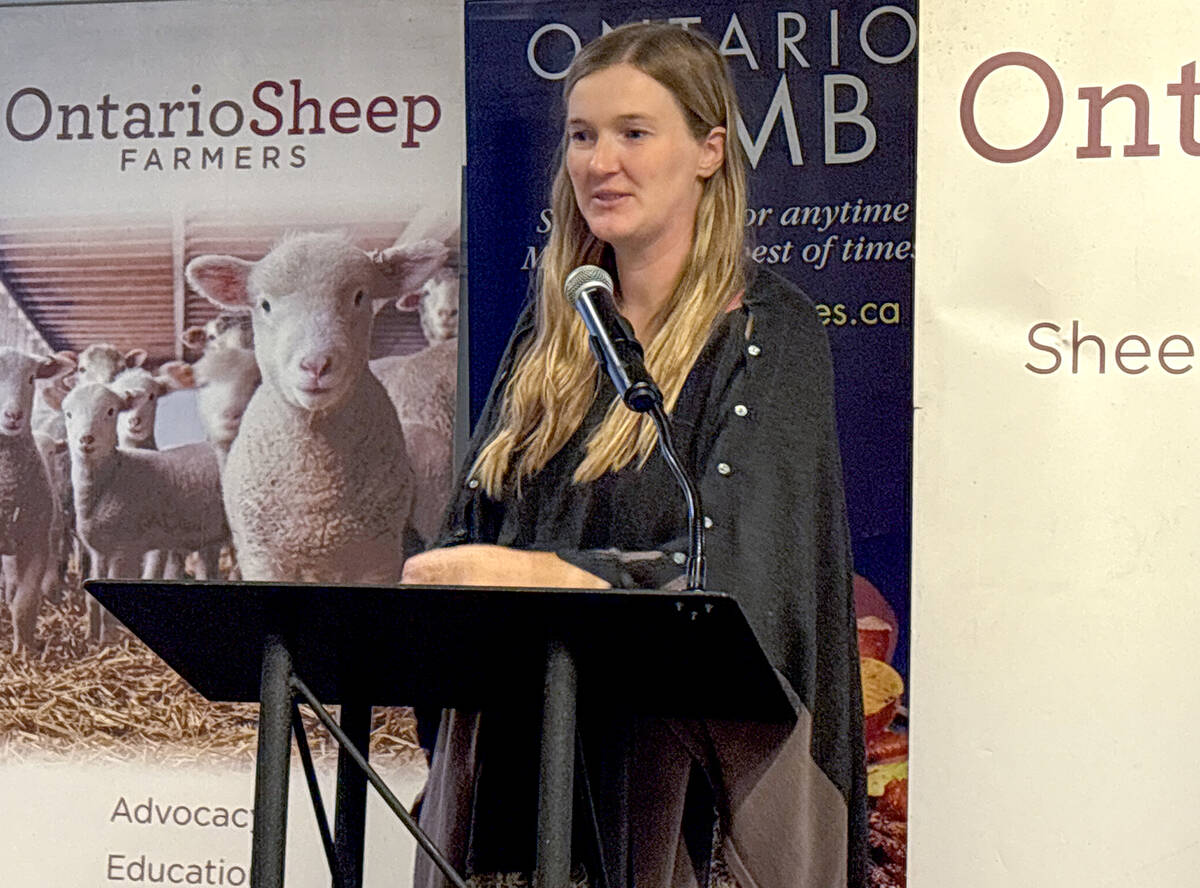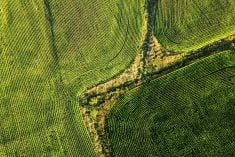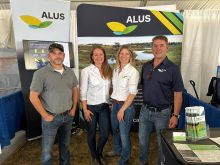New generations of activists continue their vigil over farmland known as the Pickering airport lands, 50 years into the dispute, with decades more likely before a permanent decision is made.
The original activists, a mix of environmentalists, farmland preservationists, free-love hippies and others that included then Toronto Mayor David Crombie, first took up their protest signs in 1972
Why it matters: Several of Ontario’s mainstream agricultural organizations have focused recently on farmland preservation, and the proposed airport site of more than 9,000 acres is almost all farmland.
Read Also

Footflats Farm recognized with Ontario Sheep Farmers’ DLF Pasture Award
Gayla Bonham-Carter and Scott Bade, of Footflats Farm, win the Ontario Sheep Farmers’ 2025 DLF Ontario Pasture Award for their pasture management and strategies to maximize production per acre.
Mary Delaney now heads resistance to the proposed Pickering Airport, and as chair of the Land Over Landings group, says second and third-generation opponents have now carried that torch for 50 years.
It’s an effort that amounts to “the longest continuous protest movement in Canada’s history,” the organization says.
If there’s one thing supporters and detractors of the airport proposal agree on, it’s that the situation is unique. The site selection, on the northeast edge of the Greater Toronto Area, was first acted upon 50 years ago through a controversial expropriation of farmland.
“It is inconceivable that a large parcel of land comparable in size to the Pickering Lands could be amassed again in the future,” declared a 2010 needs assessment prepared for the Greater Toronto Airport Authority (GTAA) to explore future aviation needs in the region.
In a video posted by Land Over Landings that led up to the protest’s half-century anniversary, Delaney described it as “an oasis in a sea of sprawl. You literally cross the boundary from concrete, asphalt and noise to lush green and quiet.”

The lands in question are about 9,600 acres stretching north from Highway 7 and have been owned by Transport Canada since March 2, 1972. In conjunction with a smaller provincial land grab south of the highway, designated for urban uses supporting the airport, it was expropriated by the Pierre Trudeau government.
Total Transport Canada acreage at the time was 19,800 acres but roughly half that, adjoining York Region to the west, was linked in 2013 with other provincially and municipally owned lands to create the mixed-use Rouge National Urban Park.
The volunteer-based Friends of Pickering Airport say in a report available online that they supported giving a portion of the land to the park.
“It was clear (at the time) that the federal land assembly was far in excess of what was needed for the type and role of the new Pickering airport (because) airport design and aviation technology has advanced” from what it was in the late 1960s.
The remaining 9,600 acres are sufficient, according to the GTAA, for two parallel 3,050-metre primary runways and one 2,600-metre crosswind runway. The plan was deemed “a major advantage,” by the City of Pickering in a 2018 report about the possibility of the airport’s construction, “because 3,000-metre runways can accommodate a full range of aircraft.”
The provincially expropriated tract was sold at a discount by the Mike Harris government, in many cases to the former owners. Delaney says those acres now face continual pressure from developers aiming to create the same type of single-family-home residential sprawl that stretches across much of the GTA’s outer reaches.
For aspiring farmers looking to satisfy demand for locally grown food in the region, the price for agricultural land within the former provincial expropriation tract is beyond reach.
The two visions diverge regarding the unique “opportunity” presented by 50 years of static Transport Canada ownership on the remaining 9,600 acres. Land Over Landings created a plan called “North Pickering Farms,” arguing that “the best future . . . is agriculture and agri-tourism – activities that will safeguard the natural capital, create jobs, and quickly return prosperity to the Lands.”
The organization’s plan came out of an $86,000 study by two leading agroeconomists, and envisions diverse food-themed enterprises ranging from a winery and cidery to an agricultural research centre and a small-farm business incubator.
Removing the airport designation and reverting to agricultural zoning for the entire tract, the organization’s website says, could create “an estimated 621 jobs . . . during the upgrade period, and investment expenditures estimated to reach $58 million.”
Delaney, who has lived with her family on a leased property within the Lands for 42 years, says keeping the land under federal ownership is key because it will forestall private-sector price speculation leading to urban land-use pressures.
Ideally, ownership would pass to the Parks Canada ministry and the Lands would be linked to the Rouge National Urban Park as a showcase of local food, she says.
Lease agreements would then shift from the current 10-year deals to 25 years.
A few years ago, Land Over Landings was aided by local MP Jennifer O’Connell in securing a change from one-year to 10-year leases, arguing the short term was a disincentive for land-use improvements.
So far as Delaney knows, only one farmer now lives within the federal lands. Almost all revenue earned from cash cropping goes outside Pickering, as does the revenue earned by agri-businesses serving the absentee farmers.
“Some of the local politicians here have this idea that agriculture is just one guy on a tractor, and it could be so much more.”
She says longer-term leases would incentivize people to plant orchards or erect farm buildings, and businesses serving those operations might consider setting up shop too.
“Lack of certainty is the enemy of investment in any industry, especially farming,” Delaney says.
“We have an opportunity here to create something that any city in the world would love to have: a huge piece of farmland that can help the city feed itself.”
That vision of capitalizing on the Pickering Lands opportunity stands in contrast to the vision of those who support the airport’s construction.
The City of Pickering’s website, on a page entitled “Toronto East Aerotropolis,” says an airport “could generate hundreds of millions of dollars in new investment for our aeronautic, transportation/logistics, high-tech, and other innovative sectors.”
Friends of Pickering Airport said in a 2018 commentary that “trading (an estimated) $2 million a year in crops for an airport expected to generate 400 times that and create 15,000 good jobs is an easy choice.”
But after 50 years, what evidence exists that an airport will be built? Until 2020, airport supporters held up a 2010 Transport Canada needs assessment as proof it would one day become reality. That document, according to an updated assessment released in 2020, “identified a requirement for a new Pickering Airport as early as 2027, or as late as 2037.”
The new assessment is less precise and stretches the need, if it exists, beyond 2037.
“Based on 2016 infrastructure, operational practices and aircraft mixes, the southern Ontario airports system is projected to have the capacity to support 94.7 million runway passengers per annum (PPA),” says the 2020 Transport Canada document.
“Based on anticipated conditions in 2036, the system is expected to have the capacity to support 119.6 million runway PPA.”
The 2020 needs assessment also says, “a new airport is not expected to be required in southern Ontario prior to 2036.”
Land Over Landings says that assessment is proof the airport will never be built. In a recent interview, Delaney said the research that led to the assessment was done before Canada made enhanced climate change-related commitments to cut back on fossil fuel use.
It was also done before the pandemic threw the aviation sector into turmoil from which its recovery remains uncertain.
“We’ll go from celebration and joy…to real tears for what happened to the communities that were lost,” Delaney said of the protest group’s plans for the March 2 expropriation anniversary.
She noted Prime Minister Justin Trudeau was “literally a babe-in-arms” when his father’s government obtained the land, yet still “this ill-conceived plan has not been put to bed. We call on (the current prime minister) to lift this shadow of his father on these lands.”
Friends of Pickering Airport countered by stating, “while existing airports in the GTA could be enough to handle projected growth to 2036, it was found (by the 2020 Transport Canada-commissioned report) to be desirable to start the development of a smaller industrial/specialty passenger airport now, rather than waiting to build a larger airport later.”
The two sides remain at odds. Delaney, who was a Trent University student when the original People or Planes protest began and only became aware of its history years later, pledges to remain on the watch to protect the Pickering Federal Lands from any development except agricultural or greenspace.
In a short video filmed by the lobby group to mark the 50th year since expropriation, 104-year-old Charles “Doc” Godfrey, leader of the original People or Planes protest movement, declares the proposed airport “was political baloney then and I say it’s still baloney.”
Mitch Morawetz, past-president of the Durham Region Federation of Agriculture, told Farmtario the organization hasn’t recently revisited the proposed airport issue. But a few years ago, it did officially support the Land Over Landings proposal for an agricultural redevelopment of the remaining federal lands.















